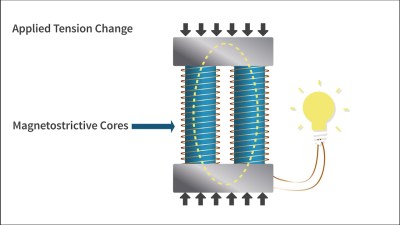“In the future, we’ll be generating a significant fraction of our electricity from harnessing the waves!” People have been saying this for decades, and wave-generated electricity is not a significant fraction of an ant’s poop. It’d be fantastic if this could change.
If you believe the owners of Oscilla Power, the main failing of traditional wave-power generators is that they’ve got too many moving parts. Literally. Metal mechanical parts and their seals and so on are beaten down by sun and salt and surf over time, so it’s expensive to maintain most of the generator designs, and they’re just not worth it.
Oscilla’s generator, on the other hand, has basically no moving parts because it’s based on magnetostriction, or rather on inverse magnetostriction, the Villari effect. Which brings us to the physics.
 Magnetostriction is the property that magnetic materials can shrink or expand just a little bit when put in a magnetic field. The Villari effect (which sounds much cooler than “inverse magnetostriction”) is the opposite: magnetic materials get more or less magnetic when they’re squeezed.
Magnetostriction is the property that magnetic materials can shrink or expand just a little bit when put in a magnetic field. The Villari effect (which sounds much cooler than “inverse magnetostriction”) is the opposite: magnetic materials get more or less magnetic when they’re squeezed.
 So to make a generator, you put two permanent magnets on either end, and wind coils around magnetostrictive metal bars that are inside the field of the permanent magnets. Squeeze and stretch the bars repeatedly and the net magnetic field inside the coils changes, and you’re generating electricity. Who knew?
So to make a generator, you put two permanent magnets on either end, and wind coils around magnetostrictive metal bars that are inside the field of the permanent magnets. Squeeze and stretch the bars repeatedly and the net magnetic field inside the coils changes, and you’re generating electricity. Who knew?
Right now, according to The Economist Magazine’s writeup on Oscilla, the price per watt isn’t quite competitive with other renewable energy sources, but it’s looking close. With some more research, maybe we’ll be getting some of our renewable energy from squeezing ferrous bars.
And while we’re on the topic, check out this recent article on magnets, and how they work.











